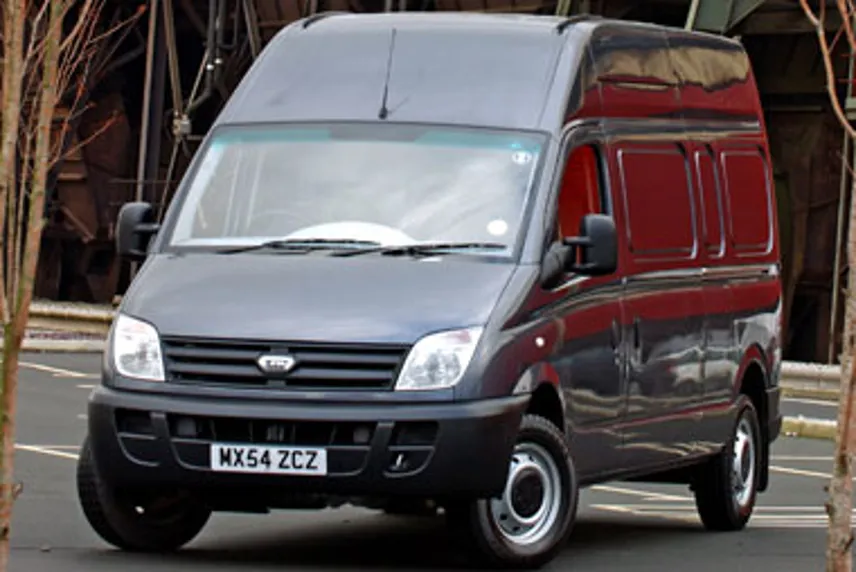Review
‘We will carry our proud professionals strategy through in everything we do, be it in manufacturing, customer service, our dealer network or our aftersales service. These are definitely not just empty words.’
Much time and effort has been put into the development of the Maxus.
The new model was tested in temperatures from -23 degrees in the Arctic Circle to 45 degrees in western Australia and there have been more than one million kilometres of road testing, including two vehicles each exceeding 250,000 kilometres.
Meanwhile a total of 16 vehicles were crashed to prove its safety credentials.
Ease of repair after a crash has also come under the spotlight, leading to class-leading low insurance groups of 10 for the SWB model and 12 for the LWB.
Last year LDV sold a total of 8.314 vans in Britain.
This year the aim is to sell around 10,000 new Maxus models.
Outside
The first thing to note about the new Maxus is that both in short and long wheelbase formats, it is a stunning looker.
Most of the opposition have opted for function over form, but the Maxus manages to cut a stylish dash as well as offering good loadspace and payloads.
The front end still has that distinctive LDV snub nose while the rest takes on a kind of Asian slant which makes the van a fusion of east and west that works a treat.
There is a large plastic front bumper and plastic rear corners but sadly no protection at all for the side panels or the wheel arches.
Some of the paintwork on our test vehicles was decidedly dodgy, but we were told these were pre-production models which had been hastily put together for testing purposes.
There were also a few raised eyebrows about fit and finish of some of the panels, but again we were promised better when the van goes on sale.
In the front
Entry to the cab is via standard remote ‘plip’ locking and climbing aboard reveals a light, airy and stylish area and a dash with all the dials contained in a large central console, leaving extra leg room for driver and passenger.
This arrangement also allows for left hand drive models to be built without creating a whole new dashboard.
Some of the journalists weren’t keen on the fact that the dials were not directly in front of the driver, but it’s an arrangement that works well in a lot of modern cars and I personally like it.
Top marks for the standard CD player and electric windows and mirrors, although some of the plastics used in the cab feel a bit cheap and nasty, especially the pull-out twin coffee cup/can holders which feel as though they could snap off at any time.
No such problems with the large cola bins in each door pocket, which should keep white van man happy guzzling away while on the move.
All the drivers’ seats in our test vehicles were the paid-for height, rake and tilt-adjustable variety with lumbar support.
They proved flat, firm and supportive, although they all seemed to wobble on their mountings, which didn’t sound too healthy.
It’s a pity that ABS brakes are a paid-for option, but at least a driver’s airbag is standard, unlike in the Mercedes-Benz Sprinter.
In the back
The business end of the Maxus features the usual sliding side door and double rear doors which open to 180 degrees.
The doors feel rather on the flimsy side compared to some of the opposition but maybe it could be argued that the rivals are over-engineered for the purpose.
It’s also worth noting that even on high roof versions, the rear doors go right up to the top of the body.
Buyers would certainly be advised to opt for the ply-lining and flat plastic floor which allows the load-lashing eyes to be countersunk.
Loads can then be slid in and out easily.
On the road
Whatever the shortcomings of this van might be, LDV has picked a winner with the common rail 2.5-litre engines, which are smooth, powerful, quiet and efficient.
I was able to test both the 90bhp and 120 bhp versions and although the more powerful engine was obviously the better unit to drive, there would be shortage of pulling power for fleet purposes with the weaker unit.
All the vans we drove were unladen and the damping felt rather on the harsh side.
I would have liked to have tried a vehicle fully laden but that will have to wait until a later date.
The steering wheel looks dinky and rather too small at first glance but it’s a clever trick to give the van a more car-like feel.
It works too and all my test drives showed this vehicle to be a cracking performer on the roads – comfortable, sure-footed and with nicely-weighted power steering.
The gearstick moves up from the floor to the dash on the Maxus, as is the norm now in this size of van. However, it isn’t the smoothest in its class and the box made an audible clunk when changing gear on several occasions.
Verdict
Let’s give a big cheer for the local lads – against all odds and facing tremendous opposition from the bigger players, LDV has produced a van which it can be proud of.
Current customers will be delighted in the quantum leap forward over current models, while buyers of rivals should take a look.
However, LDV must improve on its quality control from the models we tested before it can achieve success.
On our pre-production test vehicles, there were too many niggling faults.
















